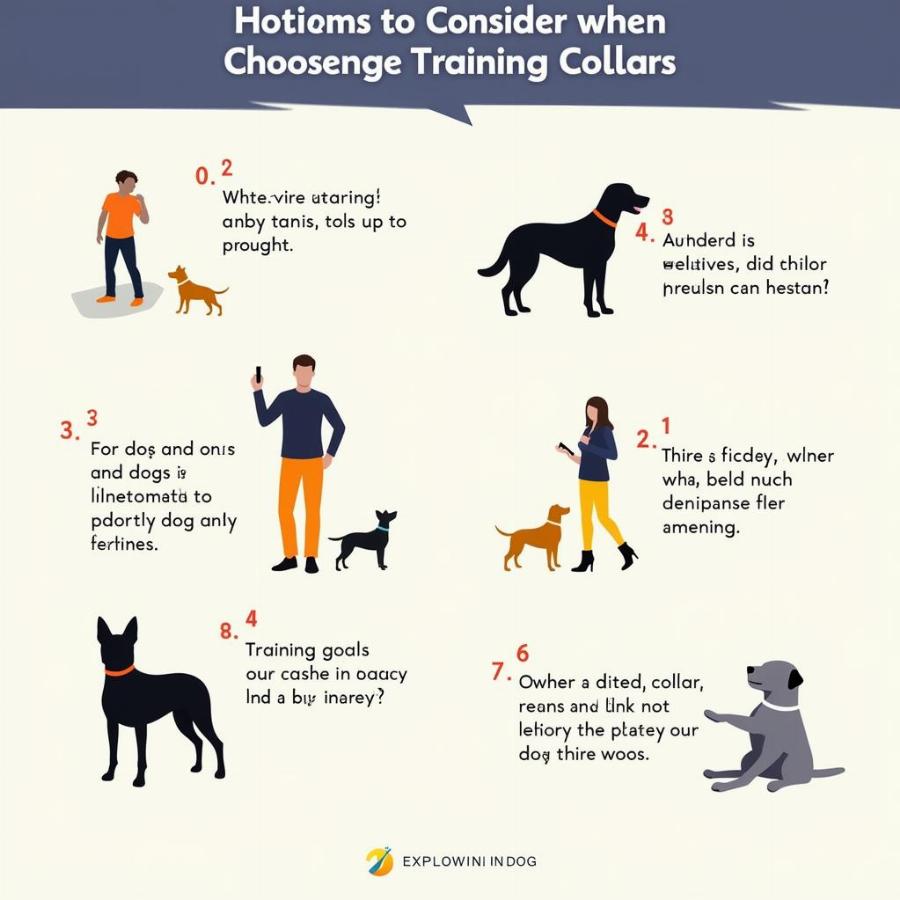Choosing the right dog training collar can significantly impact your dog’s learning experience and your relationship with your furry friend. Best dog training collars are designed to aid in communication and reinforce positive behaviors, making training sessions more productive and enjoyable for both of you. Whether you’re dealing with basic obedience, curbing unwanted habits, or addressing more complex behavioral issues, a suitable training collar can be an invaluable tool. This comprehensive guide will delve into the various types of best dog training collars available, helping you make an informed decision that aligns with your dog’s needs and your training goals.
Understanding Different Types of Best Dog Training Collars
The world of dog training collars offers a wide array of options, each designed with specific purposes in mind. Choosing the “best” depends heavily on your individual dog, their temperament, and your training style. Let’s explore some of the most popular and effective best dog training collars:
Flat Collars: The Everyday Essential
Flat collars, usually made of nylon or leather, are the most basic type of collar. While not specifically designed for training, they serve as a base for attaching identification tags and leashes, making them essential for everyday walks and outings.
Martingale Collars: Gentle Control for Slip-Prone Dogs
Martingale collars are a humane option for dogs who tend to slip out of their collars. These collars tighten slightly when the dog pulls, preventing escape while avoiding the choking effect of a traditional slip collar.
Slip Collars (or Choke Chains): Use with Caution and Expertise
Slip collars, often made of metal chain or nylon, tighten around the dog’s neck when they pull. These collars require proper training and handling to avoid injury and should be used with extreme caution under the guidance of a professional dog trainer.
Prong Collars (or Pinch Collars): For Stubborn or Reactive Dogs
Prong collars distribute pressure evenly around the dog’s neck, mimicking a mother dog’s correction. These collars are typically recommended for larger, stronger breeds or dogs who exhibit reactivity, but they should only be used under the supervision of a qualified trainer.
Shock Collars (or E-Collars): Remote Training Tools
Shock collars use electronic stimulation to correct unwanted behaviors. They offer varying levels of intensity and can be used for remote training. However, the use of shock collars remains controversial, and it’s crucial to prioritize humane training methods and seek professional guidance before considering this option.
Choosing the Right Best Dog Training Collar: Key Considerations
Selecting the best dog training collar for your furry companion involves careful consideration of several factors:
- Dog’s Size and Breed: A small dog requires a different collar size and style compared to a large breed. Certain breeds are also more prone to slipping out of collars, necessitating a martingale or similar design.
- Temperament and Behavior: A dog with a sensitive temperament might respond better to a gentle martingale collar, while a more stubborn dog may benefit from a prong collar under expert supervision.
- Training Goals: The type of training you’re undertaking influences collar choice. Basic obedience can be achieved with a flat collar and leash, while more advanced training or behavioral modification might necessitate specialized collars.
- Experience Level: If you’re a first-time dog owner, seeking guidance from a professional dog trainer is highly recommended, especially when considering collars like slip, prong, or shock collars.
 Choosing the Right Dog Training Collar: Factors to Consider
Choosing the Right Dog Training Collar: Factors to Consider
Best Dog Training Collar FAQs
Here are some frequently asked questions about best dog training collars:
-
What is the most humane dog training collar? Martingale collars are often considered the most humane option for general training, as they provide gentle control without choking.
-
Are shock collars safe for dogs? The use of shock collars is debated, and potential risks exist. Consult with a certified professional dog trainer to determine if this is an appropriate option for your dog and learn how to use it safely and humanely.
-
How do I fit a dog training collar properly? A properly fitted collar should allow you to comfortably slip two fingers between the collar and your dog’s neck.
Conclusion: Training for a Stronger Bond
Finding the best dog training collar is a crucial step towards effective and humane training. By understanding the different types available and carefully considering your dog’s individual needs, you can choose a collar that enhances communication, reinforces positive behaviors, and strengthens the bond you share. Remember, consistent training and positive reinforcement are key to success, regardless of the collar you choose.
FAQs: More Questions Answered
-
Can I use a training collar on a puppy? Yes, but consult with a vet or trainer for appropriate collar types and training methods for puppies.
-
How long should I leave a training collar on my dog? Training collars should only be used during training sessions and removed afterward.
-
What are some alternatives to shock collars? Positive reinforcement methods, clicker training, and other reward-based systems are effective alternatives to shock collars.
Beaut Dogs is your ultimate resource for all things canine. We provide comprehensive information on various dog breeds, their characteristics, and their specific care requirements. From health and nutrition to training and grooming, Beaut Dogs empowers you to become the best pet parent possible. When you need advice, reach out to us at Email: [email protected], and we’ll provide the detailed and accurate guidance you need. Visit us at Beaut Dogs today!